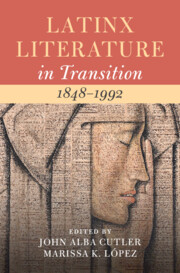Book contents
- Latinx Literature in Transition, 1848–1992
- Latinx literature in transition
- Latinx Literature in Transition, 1848–1992
- Copyright page
- Dedication
- Contents
- Figures
- Contributors
- Acknowledgments
- Introduction
- Part I Space
- Part II Being
- Part III Time
- Chapter 9 Death at and Afterlives of the Silver Dollar Café in Chicanx Cultural Production
- Chapter 10 Passing Time
- Chapter 11 Romancing Latinidad
- Chapter 12 Singing Apocalypse
- Part IV Form
- Part V Labor
- Bibliography
- Index
- References
Chapter 9 - Death at and Afterlives of the Silver Dollar Café in Chicanx Cultural Production
from Part III - Time
Published online by Cambridge University Press: 10 April 2025
- Latinx Literature in Transition, 1848–1992
- Latinx literature in transition
- Latinx Literature in Transition, 1848–1992
- Copyright page
- Dedication
- Contents
- Figures
- Contributors
- Acknowledgments
- Introduction
- Part I Space
- Part II Being
- Part III Time
- Chapter 9 Death at and Afterlives of the Silver Dollar Café in Chicanx Cultural Production
- Chapter 10 Passing Time
- Chapter 11 Romancing Latinidad
- Chapter 12 Singing Apocalypse
- Part IV Form
- Part V Labor
- Bibliography
- Index
- References
Summary
On August 29, 1970, Mexican American journalist Rubén Salazar was killed while covering the Chicano Moratorium in East Los Angeles. A gas projectile shot by a Los Angeles sheriff’s deputy ended Salazar’s life inside a local bar, the Silver Dollar Café, where he took a break from the demonstration occurring outside. In death, Salazar became a martyr of the Chicano Movement. And, as this chapter argues, the bar similarly experienced a mythical recasting in Chicanx activist consciousness and cultural production. This chapter traces two such afterlives of the Silver Dollar: first, in the photographic work of Raul Ruiz; and second, through the historical detective novel by Maria Nieto, Pig behind the Bear. I show how each respective text sets in motion a type of site-specific transformative witnessing and call to action that reverberates through time. Specifically, I analyze how this is done through the perspective of women viewing the incident of August 29 outside and inside the bar. I see this focalization as a blueprint in the establishment of the Silver Dollar Café as an ongoing political and cultural site of enduring Chicanx social change.
Keywords
- Type
- Chapter
- Information
- Latinx Literature in Transition, 1848–1992 , pp. 163 - 177Publisher: Cambridge University PressPrint publication year: 2025

